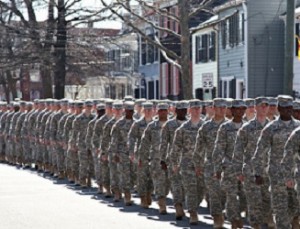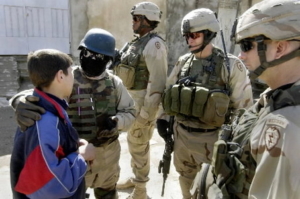
Last Sunday’s ceremony in Kabul marked the end of U.S. combat operations in Afghanistan, and subsequently, the war itself for the U.S. military. But there are no parades to celebrate the end of the war or the American service members who fought in it. Instead, military personnel are facing more draw downs and force reductions, starting with the Army.
Every military branch bulked up their numbers during the height of the War on Terror. After the war in Iraq ended in 2011, the Pentagon began devising strategies for each branch to individually reduce its force size. Initially, the Army was slated to complete its reductions in order to end up with a force of 490,000 by 2018.
Army leadership began a pro-active approach, beginning three years ago, by offering incentives for early retirement to senior enlisted and officers with over 16 years of active duty. The Army also began to involuntarily separate those individuals who would have difficulty being promoted again before their separation time. The bulk of the cuts effect the upper-middle ranks of the officer and non-commissioned officers.
For 2014, the Army offered a one-time screening for involuntary separation and early retirement, which included majors in year groups 1999 through 2003, and captains in year groups 2006 through 2008. The results of those boards determined that 550 majors and 1,144 captains would be separated from active duty. A similar screening is tentatively scheduled for Army captains in fall of 2015.
Using their proactive approach, the Army has been able to cut 62,000 personnel since the draw down began three years ago. The Army finished Fiscal year 2014 with 508,000 active duty personnel, just 18,000 members over their 2018 target force size.
But sequestration and financial pressures on the DOD have pushed up that target to the end of fiscal 2015, while also calling for an additional cut of 40,000 in both 2016 and 2017. There is also the possibility of further cuts of 10,000 to 20,000 by the end of the decade.
Another round of Selective Early Retirement Boards met in November, 2014, to consider separating colonels with dates of rank of August 2, 2008, through November 12, 2010, and lieutenant colonels who have been passed over for promotion to colonel two or more times. The results of the screening are pending approval by the secretary of the Army.
A similar force reduction method, called the Qualitative Service Program (QSP), was also used last year to identify approximately 1,000 enlisted soldiers for separation and early retirement. QSP boards will be used again in 2015 to trim the ranks of military occupational specialties that are over-strength, or that have limited promotion opportunity.
The first of the 2015 QSP boards will occur February 10th through March 6th, in conjunction with annual Regular Army and Active Guard and Reserve (Army Reserve) master sergeant board.
Other QSP boards in 2015:
- The nominative command sergeant major and key billet sergeant major board that meets June 15-19 will screen command sergeants major and sergeants major for retention.
- The sergeant first class promotion board that meets June 2ndthrough July 2ndwill screen staff sergeants for retention.
- The sergeant major training and selection board that meets September 9-25 will screen master sergeants and first sergeants for retention.
Military Connection proudly serves those who serve in the Army, Navy, Air Force, Marines, Coast Guard, Guard and Reserve, Veterans and their Families. We are the go to site for Veteran Employment and information on Veteran education. Militaryconnection.com provides Veterans with and Directory of Employers, a Job Board, information on the Post-9/11 GI Bill, and a blog that offers Veterans boundless information. Be sure to visit Militaryconnection.com, the go to site.
Military Connection: Army To See More Cuts in 2015: By Debbie Gregory





















